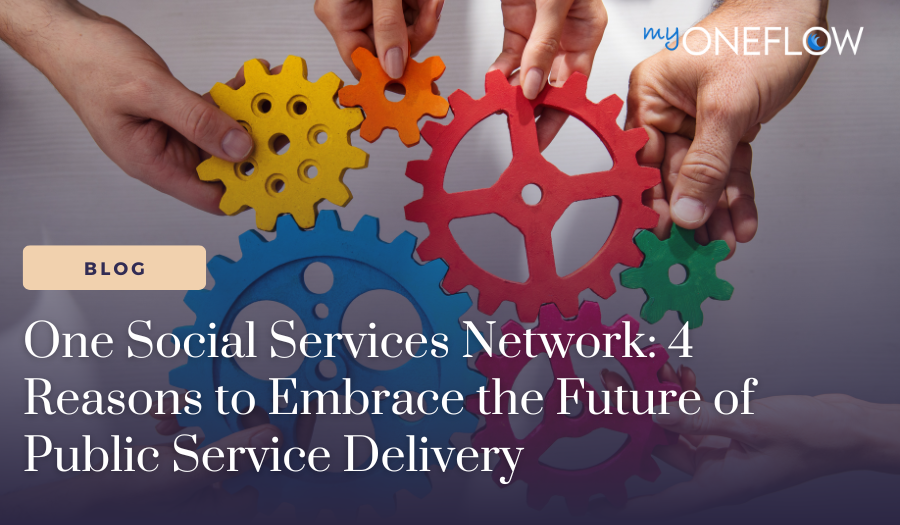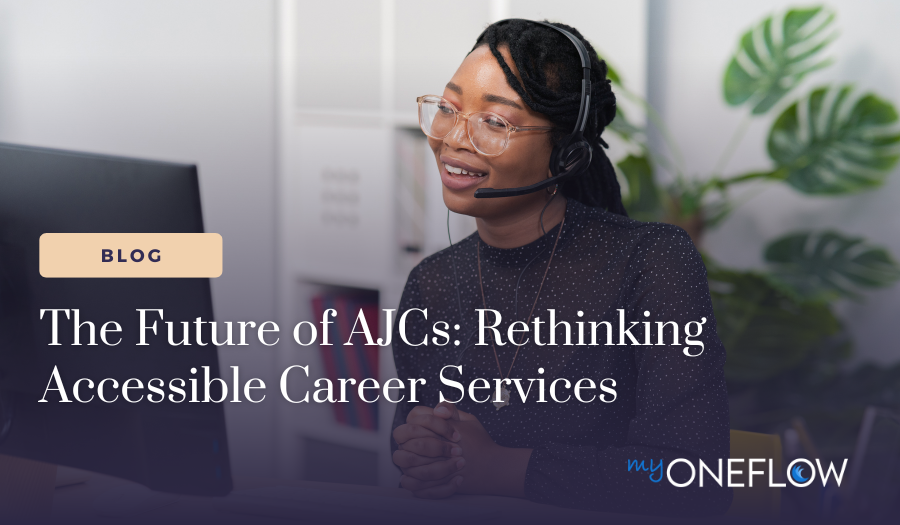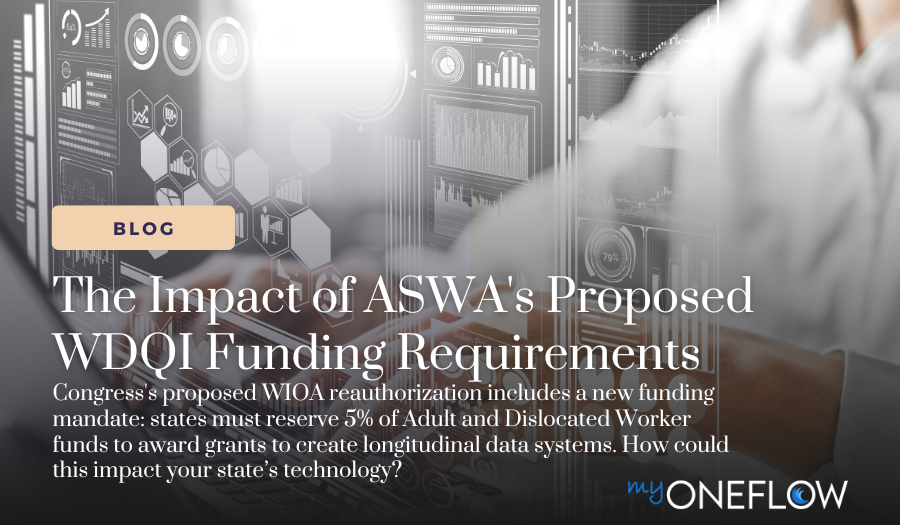The Future of AJCs: Rethinking Accessible Career Services
The rapid evolution of technology offers unprecedented opportunities to enhance the services provided by American Job Centers (AJCs). In this blog,...
4 min read
myOneFlow Staff May 30, 2024 11:01:44 AM

Government social services are crucial in supporting individuals and families in need, providing resources and assistance to significantly improve their quality of life. However, the current system for many governments and municipalities often involves navigating disparate platforms and facing administrative challenges that can hinder timely access to essential services for their constituents.
This fragmented approach not only places a burden on the participants but also on caseworkers who must juggle multiple platforms and databases to deliver the required support. Integrating networking for social services entails consolidating services such as housing assistance, workforce development, and childcare support into a single, cohesive system. This integration can streamline access and improve service delivery, making it easier for individuals to find and receive the help they need. By utilizing a unified platform, agencies can significantly reduce administrative burdens and minimize redundancies, allowing caseworkers to focus more on direct client engagement rather than navigating multiple databases and systems. In this blog post, we will explore the benefits of integrated case management for public agencies, examining how it can transform the delivery of social services and elevate the standard of care provided to those in need.
By centralizing social services, case management is more efficient and user-friendly. This integrated approach can eliminate redundant processes, reduce barriers to access, and improve the overall participant experience. When services are unified under a single platform, individuals do not need to visit multiple agencies or fill out the same information repeatedly. This reduces frustration and streamlines their journey to accessing the support they need.
Furthermore, an integrated system allows for real-time data sharing among different agencies. This means caseworkers have immediate access to up-to-date information, critical for making informed decisions. The speed and accuracy of these decisions are crucial in emergency situations where timely interventions can significantly alter outcomes.
Such centralization also enhances resource allocation. With a clearer picture of the needs and services utilized, governments can better allocate their resources to where they are most needed. This leads to more effective service deployment and potentially lower operational costs due to decreased duplication of efforts.
In a user-centered model, the simplified application process and seamless service delivery not only make the system more accessible but also restore dignity and confidence to those seeking help. By reducing bureaucratic hurdles and creating a more streamlined experience, clients are more likely to fully engage with the services available.
Understanding the impact of social services is critical for effective decision-making and resource allocation. Integrated networking offers a robust framework to provide public stakeholders with a comprehensive, high-level view of the social services landscape. By consolidating data from various agencies and service providers, an integrated network can reveal patterns, trends, and gaps in service delivery that may not be evident when examining isolated data sets.
This holistic perspective enables stakeholders to evaluate the effectiveness of existing programs and interventions more accurately. For instance, they can identify which services yield the best outcomes for particular demographics or regions, informing future program development and funding decisions. Moreover, this high-level view facilitates the identification of systemic issues, such as service redundancies or unmet needs, allowing for more targeted and efficient resource allocation.
Enabling a high-level view also strengthens accountability and transparency within the social services sector. Stakeholders, including policymakers, funders, and community members, can access reporting and analytics to gauge the impact of their investments and initiatives. This transparency fosters trust and encourages continuous improvement, as agencies are better equipped to demonstrate the efficacy of their programs and make data-driven adjustments as required.
A connected network significantly enhances the ability of government agencies to optimize resource allocation. By leveraging comprehensive data, agencies can identify gaps in existing services and pinpoint areas that require additional support. This data-driven approach ensures that funds are allocated more effectively, addressing the most critical needs within the community. Additionally, integrating various service providers within the network facilitates collaboration and coordination, reducing redundancies and ensuring that resources are utilized to their fullest potential. By fostering such synergies, agencies can enhance the overall impact of social services programs, ensuring that they are both efficient and effective in meeting the needs of the populations they serve. Ultimately, this strategic allocation of resources leads to better outcomes and a more equitable distribution of services across different demographics and regions.
An integrated case management system can play a crucial role in helping case managers and other support staff avoid burnout, a prevalent issue in the demanding social services field. By streamlining communication and coordination through a centralized platform, case managers can significantly reduce the time and effort spent on administrative tasks. This efficiency allows them to dedicate more energy to direct client interaction, often the most rewarding aspect of their job.
Real-time data sharing and updates provide case managers with accurate and immediate information, ensuring they are always well-informed about their clients' statuses. This minimizes the stress and frustration associated with outdated or missing information, leading to more confident decision-making. Furthermore, the collaborative nature of integrated networking fosters a supportive environment among case managers and other service providers. Sharing the workload and knowing that a cohesive team is working towards common goals can alleviate feelings of isolation and overwhelm.
Ultimately, reducing administrative burden, better access to real-time information, and enhanced team support contribute to a healthier work-life balance for case managers. By leveraging integrated networking, governments can help agency staff maintain higher levels of job satisfaction and reduce the risk of burnout, thereby ensuring the sustained delivery of high-quality social services.
An integrated network for social services has the power to transform government case management and dramatically improve cross-agency service delivery. It's not just a technological upgrade; it is the care model for the future and a commitment to delivering sustainable, high-quality services that meet the community's evolving needs. myOneFlow is the only government case management software with the configurability to serve large inter-agency government social services networks and is being rapidly adopted by states and cities nationwide. Contact our team today to discuss how we can design a platform to serve your community's unique needs through integrated social service case management.

The rapid evolution of technology offers unprecedented opportunities to enhance the services provided by American Job Centers (AJCs). In this blog,...

The Workforce Innovation and Opportunity Act (WIOA) was signed into law in 2014 to replace its predecessor, the Workforce Investment Act (WIA). The...

The future of workforce development is data, but successfully collecting and utilizing high-quality data remains a challenge for many WIOA-funded...